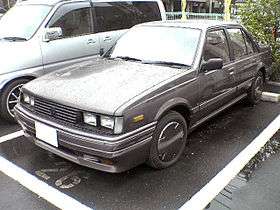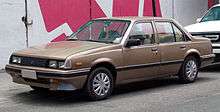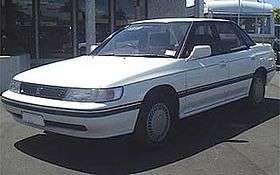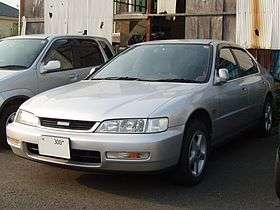Isuzu Aska
| Isuzu Aska | |
|---|---|
 | |
| Overview | |
| Manufacturer | Isuzu |
| Production | 1983–2002 |
| Body and chassis | |
| Class | Family car |
| Body style | 4-door sedan |
| Chronology | |
| Predecessor | Isuzu Florian |
The Isuzu Aska was a nameplate used by Isuzu Motors Ltd. of Japan to denote their mid-size sedans from 1983 to 2002. Originally, the Aska was a version of GM's J-car produced by Isuzu, but later, after Isuzu pulled out of manufacturing passenger cars, the nameplate was applied to rebadged Subaru Legacies (1990 to 1993) and Honda Accords (1994 to 2002) sold through Isuzu's Japanese distribution network.
The Aska replaced the Isuzu Florian in Isuzu's lineup and was discontinued in 2002 without a replacement, as Isuzu withdrew from the passenger car business completely.
The name comes from the Japanese word, "Asuka", which is the old name of the Asuka Village in the Nara Prefecture of Japan. Because the name "Asuka" may be pronounced "Ashuka" in foreign countries, the "U" was taken away from the name, presenting the model as the "Aska".
First generation (1983–1989)
| First generation | |
|---|---|
 | |
| Overview | |
| Also called |
Isuzu Florian Aska Chevrolet JJ Chevrolet Aska Holden Camira (JJ) |
| Production | 1983–1989 |
| Assembly |
Fujisawa Plant, Fujisawa, Kanagawa, Japan Arica, Chile Quito, Ecuador (Automóviles y Máquinas del Ecuador (AYMESA)) |
| Body and chassis | |
| Layout | Transverse front-engine, front-wheel drive |
| Platform | GM J platform |
| Related |
Chevrolet Cavalier Holden Camira Opel Ascona C |
| Powertrain | |
| Engine |
1,817 cc 4ZB1 I4 (JJ110) 1,995 cc 4ZC1 I4 (JJ120) 1,995 cc 4ZC1-T turbo I4 (JJ120) 1,995 cc 4FC1 diesel/td I4 (JJ510) |
| Transmission |
4/5-speed manual 3-speed automatic 5-speed semi-automatic (NAVi5) |
The original Aska was developed as a part of GM's J-car program and was a welcome replacement for Isuzu's sorely dated Florian. Contrary to fellow J-cars from other GM divisions, the Aska only came in one body style, a four-door sedan (the station wagon body style on the Florian was always relatively unpopular). The Isuzu J car variant differed most notably in the rear styling from other J-car variants. From 1983 to 1984, the Aska was known as the "Florian Aska", before being renamed simply "Aska" in 1985.
_sedan_01.jpg)
_sedan_02.jpg)
The car was launched in March 1983 with carburetted 1.8 and 2.0 litre gasoline engines and a diesel, going on sale a month later. In August 1983 the Turbodiesel followed, with 89 PS (65 kW). In October 1983, a turbocharged and fuel injected version of the 2.0 litre engine, which developed 150 PS, joined the lineup as the LJ Turbo.[1] In November 1985 a version branded by the German tuner Irmscher (specializing in Opels, they cooperated with Isuzu on some other models as well), this version featured a distinctive body kit and became somewhat of a cult object among some car fans in Japan.
In September 1984 the innovative (but ultimately unsuccessful) semi-automatic NAVi5 system became available for the naturally aspirated Aska 2.0.[2] This was a manual transmission with an electronically operated clutch, long before Alfa Romeo's Selespeed. In March 1985 the diesel also became available with the NAVi5 transmission, and from September 1986 the LG Turbodiesel was also available with it. The Aska underwent a very subtle facelift in July 1985, which was also when the "Florian" portion of the car's name was dropped.[2]
Export markets
The Aska was exported to southeast Asia, where it was known as the Isuzu JJ, and to New Zealand as the Holden Camira (JJ) between 1984 and 1987, in lieu of the JD Camira, manufactured in Australia, because the previous Australian-sourced JB Camira fared badly in the New Zealand market (nonetheless, the JD series wagon was imported concurrently from Australia). GM switched back to the updated Australian version (JE) in 1987 due to the strengthening Japanese Yen.

The Aska was also assembled in Arica, Chile from CKD kits from 1984 and sold as Chevrolet Aska in the Chilean domestic market and in Ecuador. Chilean Askas came in three equipment levels (LT, Limited, and Deluxe), with two engines and either automatic or a five-speed manual transmissions. While the two lesser versions both received a 91 PS (67 kW) 1.8-litre coupled to the five-speed, the Deluxe got the larger 2-litre with 100 PS (74 kW), only fitted with the automatic transmission.[3]
The first generation Aska was discontinued in March 1989; production totaled 108,512 cars. Isuzu did not have a contender in this segment for about a year's time, until the second generation Aska was presented.
Second generation (1990–1993)
| Second generation | |
|---|---|
 | |
| Overview | |
| Also called |
Subaru Legacy Isuzu Aska CX |
| Production | 1990–1993 |
| Layout |
FF AWD |
| Powertrain | |
| Engine |
1.8 L EJ18 H4 2.0 L EJ20 H4 |
| Transmission |
5-speed manual 4-speed automatic |
With the exception of the American market, the J platform did not continue into the 1990s. Not having the resources to develop a mid-size car on their own, Isuzu forged a short-lived alliance with Subaru. This provided for Isuzu to supply Subaru with Isuzu Bighorns (rebadged as the Subaru Bighorn), while Isuzu rebadged Subaru's mid-size Legacy sedan as the Isuzu Aska, beginning in June 1990. Both rebadged models were sold only in the Japanese market. There was also a Subaru Leone Van version briefly available, badged as the Isuzu Geminett II.
The EJ series engine was offered. in both 1.8 and 2.0 liter displacements. The engine has either single or double overhead camshaft architecture and pent-roof, cross flow cylinder firing chambers.
The 2.0 liter fuel delivery was managed with sequential multiport fuel injection, and the 1.8 liter engine used a modified fuel delivery system with single point throttle body fuel injection called SPFI. The DOHC 2.0 liter non turbocharged engine had a dual stage intake manifold.
The 2.0 liter vehicle came optional with Subaru's AWD system while the 1.8 came with FWD only. As with all other Askas, this was only ever available with four-door saloon bodywork. The Aska was discontinued in May 1993, as the Subaru deal came to an end.
Third (1994–1997) and Fourth (1998–2002) generation
| Third generation | |
|---|---|
 | |
| Overview | |
| Also called | Honda Accord |
| Production | 1994–1997 |
| Layout | FF |
| Powertrain | |
| Engine | 2.0 L F20B1 I4 |
| Transmission |
5-speed manual 4-speed automatic |
| Dimensions | |
| Length | 4,675 mm (184 in) sedan |
| Width | 1,760 mm (69 in) sedan |
| Height | 1,410 mm (56 in) sedan |
| Fourth generation | |
|---|---|
 | |
| Overview | |
| Also called |
Honda Accord Honda Torneo |
| Production | 1998–2002 |
| Layout | FF |
| Powertrain | |
| Engine |
1.8 L F18B I4 2.0 L F20B1 I4 |
| Transmission |
5-speed manual 4-speed automatic |
| Dimensions | |
| Length | 4,635 mm (182 in) sedan |
| Width | 1,695 mm (67 in) sedan |
| Height | 1,420 mm (56 in) sedan |
Later, Isuzu entered a more substantial model-exchange alliance with Honda. Among other models, it encompassed the rebadging of the Honda Accord sedan as the Isuzu Aska. This lasted for two generations - thus the third generation Aska was the fifth generation Accord and the fourth was the sixth generation Accord sedan. The Aska remained a Japanese-only model and was discontinued in 2002.
References
- ↑ Mastrostefano, Raffaele, ed. (1985). Quattroruote: Tutte le Auto del Mondo 1985 (in Italian). Milano: Editoriale Domus S.p.A. p. 485. ISBN 88-7212-012-8.
- 1 2 別冊CG: 自動車アーカイヴ 80年代の日本 [Car Graphic: Car Archives Vol. 11, '80s Japanese Cars] (in Japanese). Tokyo: Nigensha. 2007. p. 242. ISBN 978-4-544-91018-6.
- ↑ Chevrolet Aska (advertisement), GM Automotriz Chile (GMAC), 1986
External links
- (Japanese) Photos of the Irmscher Aska
- (Japanese) Isuzu Aska Owners' Club "J2" (1st-gen Askas)
| Wikimedia Commons has media related to Isuzu Aska. |